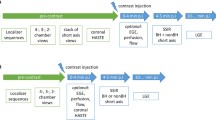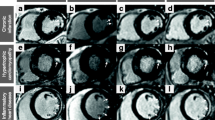Abstract
Myocardial tagging has shown to be a useful magnetic resonance modality for the assessment and quantification of local myocardial function. Many myocardial tagging techniques suffer from a rapid fading of the tags, restricting their application mainly to systolic phases of the cardiac cycle. However, left ventricular diastolic dysfunction has been increasingly appreciated as a major cause of heart failure. Subtraction based slice-following CSPAMM myocardial tagging has shown to overcome limitations such as fading of the tags. Remaining impediments, to this technique, however, are extensive scanning times (∼10 min), the requirement of repeated breath-holds using a coached breathing pattern, and the enhanced sensitivity of artifacts related to poor patient compliance or inconsistent depths of end-expiratory breath-holds. We therefore propose a combination of slice-following CSPAMM myocardial tagging with a segmented EPI imaging sequence. Together with an optimized RF excitation scheme, this enables to acquire as many as 20 systolic and diastolic grid-tagged images per cardiac cycle with a high tagging contrast during a short period of sustained respiration.
Similar content being viewed by others
References
Zerhouni EA, Parish DM, Rogers WJ, Yang A, Shapiro EP. Human heart: tagging with MR imaging—a method for noninvasive assessment of myocardial motion. Radiology 1988;169:59–63.
Axel L, Dougherty L. MR imaging of motion with spatial modulation of magnetization. Radiology 1989;171:841–5.
Buchalter MB, Weiss JL, Rogers WJ, et al. Noninvasive quantification of left ventricular rotational deformation in normal humans using magnetic resonance imaging myocardial tagging. Circulation 1990;81:1236–44.
McVeigh ER: MRI of myocardial function: motion tracking techniques. Magn Reson Imaging 1996;14:137–50.
Clark NR, Reichek N, Bergey P, et al. Circumferential myocardial shortening in the normal human left ventricle. Assessment by magnetic resonance imaging using spatial modulation of magnetization. Circulation 1991:84:64–74.
Wymann BT, Hunter WC, Prinzen FW, McVeigh ER: Mapping propagation of mechanical activation in the paced heart with MRI tagging. Am J Physiol 1999;276:H881–91.
Rogers WJ Jr, Kramer CM, Geskin G, et al. Early contrast-enhanced MRI predicts late functional recovery after reperfused myocardial infarction [see comments]. Circulation 1999;99:744–50.
Bogaert J, Maes A, Van de Werf F, et al. Functional recovery of subepicardial myocardial tissue in transmural myocardial infarction after successful reperfusion: an important contribution to the improvement of regional and global left ventricular function. Circulation 1999;99:36–43.
McVeigh ER, Atalar E. Cardiac tagging with breath-hold eine MRI. Magn Reson Med 1992;28:318–27.
Hess OM, Lavelle JF, Sasayama S, Kemper WS, Ross J. Diastolic myocardial wall stiffness of the left ventricle in chronic pressure overload, Eur Heart J 1982;3:315–24.
Hess OM, Villari B, Krayenbuehl HP. Diastolic dysfunction in aortic stenosis. Circulation 1993;87:IV73–6.
Fischer SE, McKinnon GC, Maier SE, Boesiger P. Improved myocardial tagging contrast. Magn Reson Med 1993;30:191–200.
Rogers WJ Jr, Shapiro EP, Weiss JL, et al. Quantification of and correction for left ventricular systolic long- axis shortening by magnetic resonance tissue tagging and slice isolation. Circulation 1991;84:721–31.
Fischer SE, McKinnon GC, Scheidegger MB, Prins W, Meier D, Boesiger P. True myocardial motion tracking. Magn Reson Med 1994;31:401–13.
Stuber M, Scheidegger MB, Fischer SE, et al. Alterations in the local myocardial motion pattern in patients suffering from pressure overload due to aortic stenosis. Circulation 1999;100:361–8.
Danias PG, Stuber M, Botnar RM, Kissinger KV, Chuang ML, Manning WJ. Breath-hold duration: use of magnetic resonance navigators to assess the impact of supplemental oxygen and hyperventilation. Am J Roentgenol 1998;171:395–7.
Chuang ML, Chen MH, Khasgiwala VC, McConnell MV, Edelman RR, manning WJ. Adaptive correction of imaging plane position in segmentedk-space cine cardiac MRI. J Magn Reson Imaging 1997;7:811–4.
Fischer SE. In: Zurich E, editor. Assessment of human heart wall motion by magnetic resonance imaging. Diss.; vol. 10926. Zurich: ETH Zurich, 1994.
Spiegel M, Scheidegger MB, Stuber M, Boesiger P. Ultrafast and real time myocardial motion assessment by tagging. Proc Int Soc Magn Reson Med 1998;1:279.
Author information
Authors and Affiliations
Rights and permissions
About this article
Cite this article
Stuber, M., Spiegel, M.A., Fischer, S.E. et al. Single breath-hold slice-following CSPAMM myocardial tagging. MAGMA 9, 85–91 (1999). https://doi.org/10.1007/BF02634597
Received:
Accepted:
Issue Date:
DOI: https://doi.org/10.1007/BF02634597




